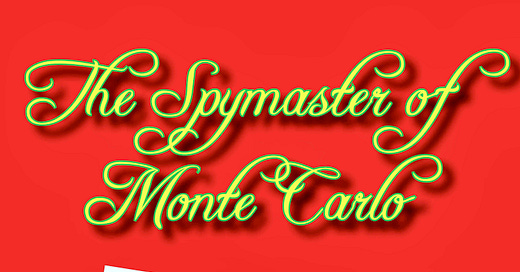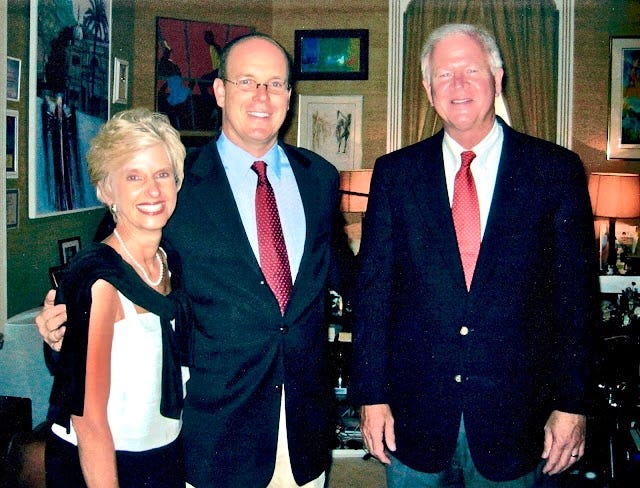THE SPYMASTER OF MONTE CARLO: 10) A U.S. SENATOR COMES TO MONACO
A Throwback Thursday Memoir of Intrigue & Lunacy
Summer, 2003
Back in Washington, D.C., I telephoned the FBI’s counterintelligence bigwig Tim Bereznay to enquire about their progress with our MING dossier.
The investigation was underway, he told me, and being run out of their Los Angeles field office because MING, with his main home in Malibu, fell under LA’s jurisdiction. Two LA-based Special Agents desired to speak with me, he added.
Meanwhile, CIA could hardly wait to try another cut around the back end.
Paris Station Chief Bill Murray phoned Prince Albert and managed to pin him down for a drink without me at the Marriot Hotel on Cap d’Ail’s port, across the street from Monaco.
Surprisingly, Albert agreed, and when I called him on it, he blamed it on mistaken identity, saying he thought he’d agreed to meet a different Bill Murray.
Maybe the actor? (L.Q. rising.…)
It was a rather lame explanation, but commoners—myself included—rarely demand further explanation from a prince, which is precisely why royalty, and Albert in particular, get away with lame explanations.
Murray, of course, was just doing his job. And the prince, in their meeting, stuck to the protocol we had agreed. So CIA finally accepted the dynamics under which we would proceed.
I carried forward with my Bureau business, meeting in Montecito, California, with two FBI Special Agents, Charles F and Teniko W, on July 16th.
They asked if I would mind taking a polygraph test.
I told them I did not mind, in principle, but did not see why I should, as I was not applying for a job to work for the FBI. Moreover, as a representative of Prince Albert it would be unseemly for me to avail myself to such a procedure.
It soon became clear the FBI would engage in a relationship with the prince and me only if I submitted to a polygraph examination, no doubt because of the nine years I’d spent doing undercover counterintelligence operations for the Bureau without ever being asked to take a polygraph.
I attempted to point out we were providing them with intelligence, not the other way around.
“If you don’t trust our dossier [on Ming] without a polygraph, throw it away,” I told them. “I’ve already done my job by giving it to you.”
So they tried a different tactic.
What about resuming work with us for payment?
I told them I had no interest in such a proposition as I already had enough to do as Prince Albert’s spymaster.
As for payment, I had one boss, Prince Albert, and I did not want to play a double game or have any conflicts of interest.
In early August, I had a rather feisty phone call from CIA Station Chief Bill Murray in Paris. He wanted to know what I knew about a U.S. Senator meeting the prince.
I knew quite a lot, and told him so.
For it was I who had scheduled such a meeting with a U.S. Senator, and I did not need CIA's permission to do so.
This was partly my way of demonstrating to CIA that the relationship should be understood for what it truly was: Liaison-plus, not CIA’s "recruitment" of the prince.
The U.S. Senator in question was Saxby Chambliss, a Republican from Georgia and ranking member of the Senate Select Committee on Intelligence.
I flew to Monaco and met with Bill Murray in the bar at Hotel Columbus, where I explained to him that Senator Chambliss had asked to be briefed and I would happily oblige him.
The prince had planned to meet Murray and me but got caught in heavy road traffic coming in from elsewhere (or so he said) and, at the last minute, cancelled his own presence.
Murray was disappointed, but he finally got the message (maybe): All intelligence goes through me, period, stop pestering the prince.
Murray provided me with a classified three-page report on Leonid Vladovich Slutsky, as we had requested. (Anything and everything classified provided to me remains so.)
Displeased with how the FBI was plodding on (or not) with MING, I gave Murray a copy of our dossier, which he happily accepted, to hell with the Bureau's systemic sluggishness. I pointed out that MING was the crux of my briefing for Senator Chambliss.
And so, on the morning of August 8th, I briefed Senator Chambliss on MING and our new relationship with CIA over breakfast in Hotel Columbus.
The Senator expressed deep concern, especially with regard to MING's self-proclaimed connection to the President’s Foreign Intelligence Advisory Board.
I took Senator Chambliss and his wife Julianne on a tour of the principality.
Following lunch at Stars & Bars, they were provided a private tour of the Palace—and an hour later I introduced Saxby and Julianne to the prince for a photo op in Albert’s turret office, followed by a substantive 25 minute meeting with the Senator.
That evening I entertained Saxby and Julianne on the prince’s behalf, first at the Vista Palace Hotel in nearby Rocquebrune for aperitifs while admiring a panoramic view from its picture windows, followed by a sumptuous supper at Café de Paris in Monte Carlo.





